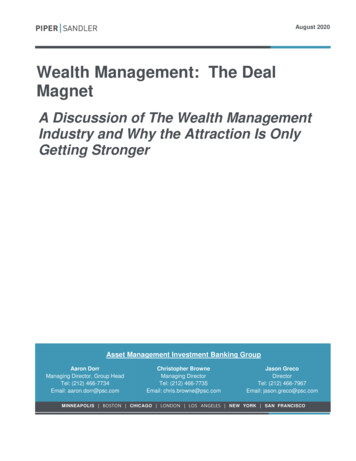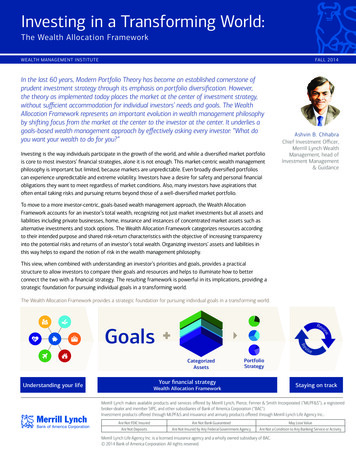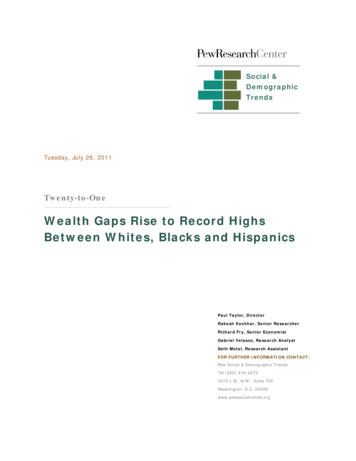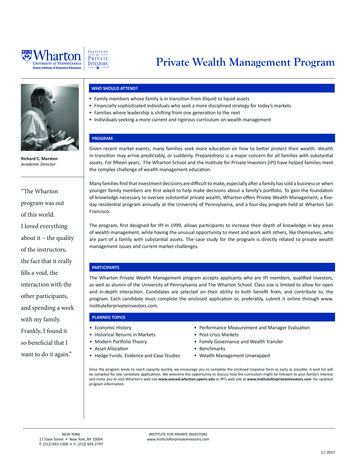
Transcription
-aAugust 2020p0Wealth Management: The DealMagnetA Discussion of The Wealth ManagementIndustry and Why the Attraction Is OnlyGetting StrongerAsset Management Investment Banking GroupAaron DorrManaging Director, Group HeadTel: (212) 466-7734Email: aaron.dorr@psc.comChristopher BrowneManaging DirectorTel: (212) 466-7735Email: chris.browne@psc.comJason GrecoDirectorTel: (212) 466-7967Email: jason.greco@psc.comMINNEAPOLIS BOSTON CHICAGO LONDON LOS ANGELES NEW YORK SAN FRANCISCO0
Table of ContentsIntroduction . 3The Shape of the Industry Today . 4A Highly Fragmented and Localized Industry . 4Compelling Business Dynamics . 6Wealth Management M&A Market . 8Broad Universe of Buyers . 8Buyer Acquisition Models . 8Valuation . 13Massive Long-Term Consolidation Opportunity . 15Appendix: Evolution of the Wealth Management Business Model. 19PIPER SANDLER 2
IntroductionSince 2017, we have witnessed an unprecedented rise in merger and acquisition activity in the wealthmanagement industry. A decade-long bull market coupled with compelling industry and businessdynamics have created a massive flow of buyers and sellers looking to partner. Despite the COVID-19pandemic, the backdrop for transaction activity in the industry remains strong. Competition amongst anever-growing group of buyers, several of which are backed by private equity sponsors, has pushedvaluations to new heights and created a virtuous circle of M&A activity.NUMBER OF U.S. WEALTH MANAGEMENT TRANSACTIONS AND TRANSACTED AUMSource: Piper Sandler; counts only transactions with target AUM greater than 100MSince 2017, deal volume in the wealth management sector has dwarfed the activity in the prior yearsand has continued to reach record levels. In 2019, 123 transactions occurred in the U.S. wealthmanagement space, 58% higher than 2018 and more than double the volume of deals in 2017. Activityhas been widespread involving buyers and sellers of all sizes and models, with the greatest amount ofselling activity occurring amongst wealth managers with less than 1B in AUM, reflecting thecomposition of the sector itself which remains dominated by smaller, independently-owned firms.One of the primary factors behind this substantial increase in deal volume has been the increasedpresence of private equity in the sector. While private equity sponsors have historically been investorsin the space, the number of private equity firms with significant scale ambitions has never been greater– both as acquirers of larger, platform businesses as their entry point into the sector and follow-onacquisitions to further scale those platforms. In total, we count 20 different platform transactions byprivate equity sponsors since 2015. Those platforms in turn accounted for 55% of the total deal activityin 2018 and 2019. Independently-owned wealth management firms which have chosen to chart theirown M&A path as buyers in recent years placed a distant second behind private equity-backedplatforms, accounting for approximately 20% of the deal volume over the same 2018-2019 period.Lastly, strategic buyers including banks, broker dealers, traditional asset managers and insurancecompanies have continued to play a role in the activity, albeit a minor one as they have foundthemselves frequently outbid in the high-flying market.PIPER SANDLER 3
U.S. WEALTH MANAGEMENT TRANSACTIONS BY TARGET AUMSource: Piper Sandler; counts only transactions with target AUM greater than 100MIn this report, we explore the current state of the wealth management industry and the backdrop for itsthriving M&A market, while shedding light on the universe of buyers, notable buyer acquisition modelsand valuation. Lastly, we share our views for the significant consolidation that we expect will continuewell into the future.The Shape of the Industry TodayA Highly Fragmented and Localized IndustryWealth management is a highly fragmented industry that is geographically and regionally focused. Asa result, the industry can be difficult to accurately size and succinctly define from the broader universeof Registered Investment Advisers (“RIAs”). SEC data shows that there are currently 13,000 registeredinvestment advisers. However, a large portion of those 13,000 RIAs focus on managing assets for aninstitutional client base and/or for retail clients, either directly or through intermediaries. By focusingonly on RIAs that (i) serve a client base predominantly comprised of high net worth/wealthy individualsand (ii) primarily manage assets on a discretionary basis, we can identify a subset of 6,600 RIAs.These RIAs, representing approximately 50% of the total, collectively advise on a sizable 9.8T inregulatory assets under management. When viewing this subset by size of RIA, the fragmentation ofthe advisor base becomes clear with nearly 5,800 firms, or approximately 90% of the subset notedabove, managing under 1B in client assets.PIPER SANDLER 4
NUMBER OF SEC-REGISTERED WEALTH MANAGERS BY AUM SEGMENT1Source: U.S. Securities and Exchange Commission, Piper Sandler AnalysisThe industry’s fragmentation is driven by a few key factors:Low Barriers to Entry – Launching a wealth management firm, particularly compared to other financialservices businesses, has historically entailed low start-up costs with little upfront capital and minimalregulatory requirements. In addition, the availability of third-party middle and back-office serviceproviders has permitted entrepreneurial advisors to readily “rent” the services that they need to run theirbusinesses. This ability to outsource alleviates one of the key frictions of starting a new RIA andliberates advisors to focus their primary efforts on sourcing and servicing clients as their businessgrows.Local Focus – Wealth management firms are typically locally-focused in a certain city or area. Clientbases are developed organically, mainly via existing client referrals, local marketing campaigns andseminars, and referrals from local centers of influence including prominent members of the businesscommunity and other professional advisors such as accountants and lawyers. Expansion beyond anRIA’s local market can require significant costs and senior management resources, ultimately with anunpredictable outcome. As a result, many RIAs choose the more predictable path of further penetratingtheir local market.Shift to Independence – The backbone of many wealth management firms is the close personalrelationship developed between the advisor and his/her clients – a relationship often strengthened overmany years. This goodwill built up between client and advisor often exists at the personal level, and insome cases outweighs any connection a client may have with the advisor’s firm. This close clientrelationship creates a greater portability of client base, giving advisors greater flexibility, confidence andfreedom to migrate to smaller independent RIAs or to launch their own firm. The migration has oftenbeen at the expense of the wirehouses and regional broker dealers, which have frustrated their advisorbase with frequently changing pay grids that misalign incentives and onerous compliance regimes.Facilitation of Technology – The technology options that have become available to RIAs over the pastdecade have provided a strong backdrop to support the shift to independence discussed above. As aprecursor, technology dramatically decreased the dependence advisors previously had on largerinstitutions. In fact, the immense scale and infrastructure of large institutions, which was once their1U.S. Securities and Exchange Commission. Includes only SEC-Registered Investment Advisers that havediscretion over 50% of assets and serve a client base made up of greater than 50% private clients.PIPER SANDLER 5
biggest value proposition for advisors, caused them to fall behind their more nimble competitors.Among smaller firms and independent RIAs, approximately 30% outsource all back office functionswhile 60% outsource some portion of those functions2, highlighting the broad acceptance ofoutsourcing to manage meaningful elements of day-to-day operations.Compelling Business DynamicsBeyond the conducive industry backdrop, wealth management firms exhibit highly attractivecharacteristics which continue to drive buyer interest in the space – thus propelling M&A activity.Strong Underlying Fundamentals – The wealth management industry, unlike other sectors of theinvestment management industry, has long held fundamental strengths, which we expect will endurewell into the future, from which businesses naturally benefit and thus have built strong franchises.Chief among those fundamentals is underlying client growth –both in the number of high net worthindividuals (“HNWI”) and their overall wealth. According to Capgemini, the North American HNWIpopulation exceeded 6.9M as of 2019, which represents a 7% increase from 2018, and a 47% increasefrom 2013. In addition, their overall wealth increased to greater than 21T in 2019 from 15T in 2013,a growth rate of over 45%. Beyond growth in their client base, wealth management firms haveexperienced fee compression to a much lesser extent than the broader investment management sectordespite low-cost entrants to the space such as robo-advisors and the like. Unlike the retail mutual fundspace, for example, which has seen 14% fee compression over the past 10 years, wealth managershave not faced the same pressures, due in large part to the strength and duration of their clientrelationships and the wide array of services they typically provide.Attractive, Consistent Organic Growth – Typical wealth management firms have steady, modest organicgrowth given the local nature of their businesses, their dependence on word-of-mouth, local centers ofinfluence (“COIs”), and referrals from existing clients. On average, firms with 250M or more in clientassets reported five-year organic growth and client CAGRs of 5.1%, and 5.4%, respectively. Thegrowth, while modest, has proven to be highly consistent across market cycles. Additionally, portfolioinvestment returns provide incremental AUM increases with few incremental costs, effectively creatinga double-digit annual growth rate when coupled with organic growth from client flows.2014 – 2018 ORGANIC GROWTH3Source: Charles Schwab23Northern Trust. “External Investment Management Survey.” 2016Charles Schwab. “RIA Benchmarking Study.” 2019PIPER SANDLER 6
The primary source of organic growth is referrals from existing clients which, on average, contributes51% of an advisor’s new assets each year. Other marketing efforts, such as marketing campaigns,seminars and general solicitations are the second largest contributor of organic growth, representing32%. However, the scope of these efforts should be kept in perspective. COI referrals, while onlycontributing 17% to total organic growth figures, remain an important component of a wealth manager’sorganic growth strategy, with successful client outcomes serving only to strengthen the relationship withthose COIs and encourage future referrals.SOURCES OF ORGANIC GROWTH4Source: Charles SchwabHigh Client Retention – Clients of wealth management firms are typically extremely loyal and spanmultiple years, with industry annual client retention rates well in excess of 90%. As clients continue toaccumulate wealth, their financial lives become more complicated and the need for professional adviceonly increases. As the relationship grows, clients utilize other services such as financial planning, taxplanning, insurance brokerage and estate & trust services. These value-added services furtherreinforce trusted and deeply personal relationships with clients and contribute to strong retention rates,as the process of making a change can be extremely involved and complex. As shown below, clientretention rates increase with level of wealth, as clients with investable assets in excess of 1M haveretention rates greater than 95%. This ‘stickiness’ of clients creates an attractive stable and predictablerevenue stream.CLIENT RETENTION AND HOUSEHOLD ASSETS 5Source: PriceMetrix45Charles Schwab. “RIA Benchmarking Study.” 2019PriceMetrix. “Stay or Stray: Putting Some Numbers Behind Client Retention.”PIPER SANDLER 7
Wealth Management M&A MarketBroad Universe of BuyersWealth management businesses have long generated interest from a diverse group of buyers. All aredrawn to the industry for its strengths as discussed above, though in addition each buyer type hasdistinctive views which generally headline their interest in the space.Wealth Managers – Encompassing independent wealth managers, private equity-backed wealthmanagers, and wealth managers that sit within larger financial institutions, these firms have been themost prolific acquirers in the space. Independent wealth managers, while being highly attractiveacquisition targets themselves, typically focus on the numerous opportunities that exist on the lowerend of the size spectrum to integrate within their businesses and add scale. Wealth managers withprivate equity backing benefit greatly from the deep pockets and extensive deal making experience oftheir financial backers. Sponsors can provide assistance and additional resources to develop andinstitutionalize the M&A strategy at a wealth manager, ultimately expanding both the array and volumeof opportunities a firm may consider. Wealth managers that sit within larger financial institutions havebeen the catalyst behind some of the most publicized deals in recent years, typically focused on largeopportunities that meaningfully move the needle. Each of these groups pursue acquisitions as a way tocapture economics of scale and build market-leading franchises.Banks – While one of the original buyer groups of wealth management firms, banks have seen theirshare of wealth management deals diminish in recent years as increased competition has driven upvaluation for high-quality wealth businesses in attractive geographies. Banks, highly interested inincreasing contribution from fee-based revenues and the opportunity to cross-sell banking products towealth management client bases, must balance their interest with the regulatory capital ratio impactsbrought on by goodwill-heavy transactions.Broker Dealers – Broker dealers, while typically focused on recruiting individual advisers and adviserteams away from competitors, are also active acquirers of wealth management firms. Broker dealersoften look to acquire hybrid, or dually-registered, targets, as the target is able to retain certain revenuestreams, such as mutual fund trailers and commissions, that would otherwise be lost if they wereacquired by a traditional wealth manager. In addition to achieving greater scale in their wealthmanagement business lines, broker dealers are highly attracted to the recurring fee-based revenuesassociated with wealth managers.Financial Sponsors – Financial sponsors have recently driven significant M&A activity in the space,primarily by backing larger, at-scale wealth management firms and aggressively acquiring smallerbusinesses to roll them into the platform. Sponsors look to build businesses increasing both bottomline growth and expanding valuation potential, ultimately supporting a strong exit into the hands of afellow financial sponsor, who will look to continue the same growth approach, or a strategic owner.Buyer Acquisition ModelsFor owners of wealth management firms, there are an array of buyer acquisition models to considerwhen selling a business. The models vary in the degree of integration, ownership structure andgovernance – ultimately leading to a different experience in post-transaction day-to-day operations foracquired firms. On one end of the spectrum, buyers employing a “multi-boutique” business model limitthe integration of acquired firms, allowing them to retain equity, their own branding and a certain degreeof governance and autonomy. At the other end of the spectrum is the fully integrating approach inwhich a buyer combines acquired firms with the buyer and offers one homogenous wealth managementplatform and brand to clients. In addition, a growing number of minority-stakes buyers have emergedPIPER SANDLER 8
which are attracted to the steady cash flows of the wealth management sector. This group typicallyacquires minority economic interests in target firms and does not have any control rights beyond certainminority protections.Within each acquisition model, acquirers have their own preferences and thus in practice the modelswill not be exactly the same. Universally, buyers will expect key employees of the target firms to enterinto employment agreements with non-compete / non-solicit provisions. The specific terms will vary bybuyer, but will include multi-year seller commitments and may have added terms relating to anyretained equity, particularly in regard to future liquidity.COMPARISON OF ACQUIRER MODELSIntegratingMulti-BoutiqueMinority FinancialPercent Acquired 100% 40-70% Typically 25%Support forBusiness Growth Leverage acquirer’sscale and resources Centralize marketingfunctions at the broaderfirm level Enable advisors tofocus exclusively onnew and existingclients May assist directly withlead generation Access to capital andexpertise for M&Aopportunities Scale benefits,including pricingpower for technologyand access toinvestments Organic growth bestpractices andcoaching initiatives Informal strategicguidance as desired Ad hoc value add Potential opportunityto leverage for M&AfinancingDegree ofInvestmentAutonomy Expected thatinvestment decisionsalign with overall firmphilosophy Investment functioncan be centralized tovarying degrees withthe acquirer Retain completecontrol of investmentprocess and strategyGovernance Brand Retention One brand, fullyintegrated into existingplatform Complete integration ofmiddle and back office Largely agnostic oninvestment processand strategy, subjectto complianceoversight No consolidation ofinvestment function Portfolio managementremains at the firmlevel Retain operationalcontrol of theirbusiness Acquirer may beinvolved in budgeting Acquirer has approvalrights overacquisitions and largecapex decisions Typically retain theirbrand unless acquiredby existing boutique Typically nointegration, continueto manage middle andback office functionsIntegration ofMiddle and BackOfficeLargely expected toconform to standardoperating practices ofthe acquirer Retain operational andvoting controlAcquirer has someminority rights aimedto protect principal Brand is unaffected No integrationSource: Piper SandlerPIPER SANDLER 9
Integrating Model – Integrating acquirers leverage their strong, well-branded presence and fullydeveloped platform to attract acquisition targets. Following a transaction, acquired firms are fullyintegrated into the acquirer, including taking on the acquirer’s brand, though the acquired advisorstypically maintain their primary roles of client relationship management. Nearly all the businessfunctions of the acquired firm are consolidated into the parent, including marketing and new client/leadgeneration in some cases. This centralization of middle and back office functions enables advisors tofocus on their clients and to free themselves from day-to-day administrative responsibilities.Firms operating an integrating model generally have a clearly defined investment managementapproach, which is typically open architecture or hybrid (as described above). While completecompatibility is typically not a day one requirement, the intention is for acquired firms to conform to theinvestment management approach of the larger parent in order to reinforce the single brand andpresent a consistent experience across clients. Integrating acquirers will often initially pursue a “do noharm” approach to integration in order to minimize the impact to acquired firms’ clients. Generallyspeaking, the more different the business model at a given target in relation to the acquirer, the moregradual the integration of that target into a given buyer.A defining characteristic of the integrating model is a transaction structure whereby the buyer acquires100% of the seller’s equity, in contrast with the multi-boutique model in which sellers retain equity. Inorder to align incentives, sellers will often have incentive compensation post-transaction that rewardscontinued growth of their books of business and may have the opportunity to participate in the upside ofthe parent company through real or phantom equity programs. Among acquirers, the integrating modelis the most common today as it provides the greatest scale benefits to the acquirer and facilitates auniform delivery to the client base across advisors.SUMMARY OF ACTIVE INTEGRATING ACQUIRERSNote: Includes select acquirers that have completed a minimum of two transactions in the last three yearsIntegrating ModelFirmApprox.AUMFinancial BackerSelect Firm Acquisitions 8BParthenon CapitalCapstone Capital ( 100M); Houston AssetManagement ( 450M); RAA ( 2.8B); Siena WealthManagement ( 250); HBP Retirement Group ( 235M) 4BPublic(NASDAQ: AUB)Outfitter Advisors ( 400M); Dixon, Hubard, Feinour, &Brown ( 600M) 10BAbry PartnersFerrell Wealth Management ( 460M); Heller WealthAdvisors ( 387M); TPW Financial ( 300M) 64Bn/aSignature Family Wealth Advisors ( 4.3B); MeritageCapital ( 1.0B); Highmount Capital ( 2.3B) 45BGTCR 12BLong Ridge EquityPartners 25BLightyear CapitalLakeside Wealth ( 1.6B); Welch Hornsby ( 5.5B);Fountain Financial ( 654M); Boston Advisors WM( 1.5B); South Texas Money Management ( 3.7B)Cadwell Wealth ( 182M); Ruggie Wealth Management( 566M); Spectrum Management Group ( 575M);Pinnacle Financial Group ( 1.1B)Sullivan & Serwitz Investment Advisors ( 1.0B);Executive Monetary Management ( 3.0B); KartstenFinancial Services ( 500M)PIPER SANDLER 10
45BGeneral Atlantic 10Bn/a 29BFranklinResources(NYSE: BEN) 49BPublic(NASDAQ: FITB)Lenox Wealth ( 600M); Thun Financial Advisors( 600M); Starfire Investment Advisors ( 560M);Sunrise Advisors ( 700M); Coe Financial ( 126M)PagnatoKarp ( 2.3B); True Capital Management( 1.2B); Cypress Wealth Advisors ( 500M); EvanstonAdvisors ( 500M)Pennsylvania Trust Company ( 4.0B); Athena CapitalAdvisors ( 6.0B)Franklin Street Partners ( 2.2B); The RetirementCorporation of America ( 461M) 8Bn/aNorthern Oak Wealth Management ( 800M); PremierAsset Management ( 550M) 34BWarburg PincusRetirement Wealth Specialists ( 400M); Vector Wealth( 1.1B); Beacon Financial ( 800M); Believeland( 400M); Hickory Asset Management ( 173M) 375BPublic(NASDAQ: LPLA) 33Bn/a 16BOak Hill Capital 6.4BPublic(NASDAQ: PGC) 19BViking Global 7BThe CynosureGroup 21B 17BPublic(NASDAQ: SAMG)TA AssociatesE.K. Riley Investments ( 2.0B); Lucia Securities( 1.5B); Allen & Company of Florida ( 988M)Wealth Health ( 400M); Snow Creek Wealth ( 300M);SMS Capital ( 110M); Singer Xenos ( 1.3B); AuthentAdvisors ( 285M)Summit Wealth ( 130M); M.J. Smith & Associates( 910M); ClearRock Capital ( 557M); Argosy WealthManagement ( 330M); First Ohio Planning ( 350M)Point View Wealth Management ( 300M); LassusWherley & Associates ( 500M); Quadrant CapitalManagement ( 400M)Financial Clarity ( 2.3B); Greer Anderson Capital( 110M)Huber Financial ( 1.6B); Kingston WealthManagement ( 150M); D3 Financial Counselors( 290M); Orion Capital Management ( 150M)Cortina Asset Management ( 1.7B); Neosho Capital( 168M); Jamison Eaton & Wood ( 1.0B); Ten-SixtyAsset Management ( 1.9B); Milbank ( 500M)JOYN Advisors ( 1.3B); BPU Investment Management( 517M); RCL Advisors ( 1.4B); AEPG ( 1.0B);Planning Solutions Group ( 683M)Source: Piper SandlerMulti-Boutique Model – The multi-boutique model targets large independent wealth managers,particularly those with business and operational skills that do not necessarily require being part of alarger firm, but can generate organic and inorganic future growth. The acquired firm generallymaintains separate branding and operations post-transaction. From the perspective of the acquiredfirms’ clients there is generally minimal or no impact, which is often an appealing aspect for sellers.The extent that business processes are provided by a central platform at the parent company varies bybuyer. Some acquirers standardize only the minimum level of business processes across theiracquired firms – consisting of back-office functions such as payroll, cash management, firm-widePIPER SANDLER 11
insurance, compliance and financial reporting – and provide support for other functions such as humanresources and legal operations. Other acquirers leave it to the acquired firms to determine theirpreferred degree of operational integration and support from the parent. While some models provide afull suite of proprietary technology, others are technology-agnostic but can provide scale benefits suchas enterprise pricing on middle and back-office technology solutions.Acquirers operating a multi-boutique business model often acquire 40-70% of the equity of the sellers.This provides a strong alignment of interest between seller and buyer as sellers remain materiallystaked in the business while buyers are able to secure a meaningful ownership position. The portion ofearnings retained by the management of the target firm provides selling shareholders with distributionsthat will fluctuate along with the profitability of the firm, and which can be sold to the next generation ofmanagement when the current generation retires.SUMMARY OF ACTIVE MULTI-BOUTIQUE ACQUIRERSMulti-Boutique ModelFirmApprox.AUM 132B 200BFinancial BackerPublic(TSE: CIX)Stone Point /KKR / Public(NASDAQ: FOCS) 57BThomas H. LeePartnersSelect Firm AcquisitionsBalasa Dinverno Foltz ( 4.5B); Congress Wealth( 2.3B); Cabana Group ( 1.1B); One Capital ( 1.6B);Surevest Wealth ( 370M)MEDIQ Financial (n/a); Nexus InvestmentManagement ( 2.2B); Williams, Jones & Associates( 7.7B); Escala Partners ( 3.5B); Prime Quadrant( 3.4B)Teak Tree Capital Management ( 600M); FrontierInvestment Management ( 3.3B); Schultz Collins( 1.0B); Lexington Wealth ( 1.0B); Green SquareWealth Management ( 2.6B)Source: Piper SandlerMinority Financial Acquirer Model – Minority acquirers primarily look to participate in the cash flow ofthe acquired businesses. Generally, these firms are financial buyers that leave control in the hands ofthe sellers and typically provide less support relative to multi-boutique and consolidating acquirers. Theacquired stakes are typically under 25% to avoid triggering a regulatory change-of-control event whichwould require soliciting consents from the target’s clients. Additionally, sellers generally value that,depending on the ownership structure, minority investments may not require disclosure on the firm’sForm ADV.The acquisition of the interests can be structured as either a revenue share or profit share and mayinclude terms that ensure protection of invested capital given the passive nature of the interest. Theminority model provides sellers with the option to receive cash and diversify their net worth while alsoretaining control of their business. Consideration received in a transaction can be used to provideliquidity to the selling owners, help effectuate equity transfers to the next generation, make additionalinvestment into the business and pay down debt.Predictably, retention of control and future upside is the defining characteristic of a minority sale. Whilesome minority investors are strictly interested in receiving quarterly distributions, others may view aminority investment as a way of getting a foot in the door in the wealth management sector. In thoseinstances, minority transactions may be structured to provide a path to greater future ownership for theacquirer, and in turn, future liquidity for the sellers.PIPER SANDLER 12
Acquirers among this group include specialist investors focusing specifically on the sector as well asprivate equity firms that are interested in making an investment in the space but with a target whosestrategy is not centered on being a platform for consolidation.SUMMARY OF ACTIVE MINORITY FINANCIAL ACQUIRERSMinority Financial AcquirerFirmApprox.AUMFinancial Backer 57BNew York PrivateBank & TrustHollencrest Capital ( 1.7B); Pure Financial Advisors( 2.4B); Parallel Advisors ( 3.0B); Stratos Wealth( 14.5B); NorthRock Partners ( 1.5B) 49BWhite MountainsInsurance GroupSequoia Financial Group ( 4.7B); First Long Island( 1.6B); B O S ( 4.76B)n/aBBR Partners ( 17.9B)Markel Corp.(NYSE: MKL)Clearstead Advisors ( 5.7B); Wilbanks Smith &Thomas ( 3.5B)LincolnPeakn/aSelect Firm AcquisitionsSource: Piper SandlerValuationIn recent years, the strong demand for wealth management firms from well-capitalized buyers seekingto consolidate in the sector has driven up valuations across the industry. Businesses continue to bevalued based on earnings, but underpinning any valuation are several important factors.ILLUSTRATIVE DRIVERS OF VALUE FOR WEALTH MANAGEMENT FIRMSSource: Piper SandlerPIPER SANDLER 13
In viewing the drivers of value for wealth management firms in a potential transaction, we distinguishbetween those fundamental components, which can be thought of as core components to underpingeneral interest from potential buyers and the key components that drive premium valuations. Whilesubjective to an extent, the strongest valuations and frequently most successful transactions often
Wealth Management: The Deal Magnet A Discussion of The Wealth Management Industry and Why the Attraction Is Only Getting Stronger Asset Management Investment Banking Group Aaron Dorr Managing Director, Group Head Tel: (212) 466-7734 Email: aaron.dorr@psc.com Christopher Browne Managing Director Tel: (212) 466-7735 Email: chris.browne@psc.com











